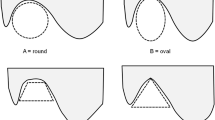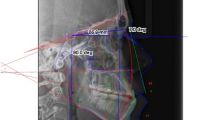Summary
INTRODUCTION: The mandibular fossa (MF) connects the mandible to the cranium through a bilateral articulation. It is suggested that the mandible and the temporal bones have a reciprocal effect on their position and movement, acting as a temporo-mandibular unit. The purpose of this study was to analyze the possible role of the mandibular fossa in the development of malocclusion by comparing its three-dimensional (3D) position in different dentoskeletal frames in caucasic European human skulls. METHOD: Several 3D angular and linear measurements obtained from Cone Beam Computerized Tomography scanning images of 101 skulls from the Weisbach collection at the Vienna Natural History Museum were analyzed. RESULTS: The position of MF varied in different dentoskeletal frames. The sagittal position measured from the Nasion or Sella landmark was significantly smaller in Class III compared with the other two groups. The vertical position of MF did not differ significantly amongst groups. Two effective ways of evaluating the MF sagittal position are to measure the 3D distance from MF mean landmark to the fronto-nasal suture (Nasion) or to the Sella landmark. CONCLUSION: The MF position is suggested to be considered an important factor in the development of malocclusions. Its influence on the position of the mandible supports the idea of a temporo-mandibular unit. Analysis of the position of MF should be included in the diagnostic process.
Similar content being viewed by others
References
Adam GL, Gansky SA, Miller AJ, Harrel WE Jr, Hatcher DC. Comparison between traditional 2-dimensional cephalometry and a 3-dimensional approach on human dry skulls. Am J Orthod Dentofacial Orthop 2004;126(4):397–409
Agronin K, Kokich V. Displacement of the glenoid fossa: a cephalometric evaluation of growth during treatment. Am J Orthod Dentofacial Orthop 1987;91:42–8
Baccetti T, Antonini A, Franchi L, Tonti M, Tollaro I. Glenoid Fossa position in different facial types: a cephalometric study. Br J Orthod 1997;24:55–9
Barnett G, Higgins D, Major P, Flores-Mir C. Immediate skeletal and dentoalveolar effects of the crown-or banded type Herbst appliance on Class II division 1 malocclusion. Angle Orthod 2008;78:361–9
Bastir M, Rosas A, Kuroe K. Petrosal orientation and mandibular ramus breadth: evidence for an integrated petroso-mandibular developmental unit. Am J Phys Anthrop 2004;123:340–50
Bastir M, Rosas A. Hierarchical nature of morphological integration and modularity in the human posterior face. Am J Phys Anthrop 2005;128:26–34
Bastir M, Rosas A. Correlated variation between the lateral basicranium and the face: a geometric morphometric study in different human groups. Arch Oral Bio 2006;51:814–24
Bastir M, Rosas A, Lieberman DE, O'Higgins P. Middle cranial fossa anatomy and the origin of modern humans. Anat Rec 2008;291:130–40
Droel R, Isaacson R. Some relationships between the glenoid fossa position and various skeletal discrepancies. Am J Orthod 1972;61:64–78
Enlow D, Hans M. Essentials of facial growth. Philadelphia: WB Saunders Co; 1996
Flores-Mir C, Ayeh A, Goswani A, Charkhandeh S. Skeletal and dental changes in Class II division 1 malocclusions treated with splint-type Herbst appliances. Angle Orthod 2007;77:376–81
Fuentes M, Opperman L, Buschang P, Bellinger L, Carlson D, Hinton R. Lateral functional shift of the mandible: Part II. Effects on gene expression in condylar cartilage. Am J Orthod Dentofacial Orthop 2003;123:160–6
Fushima K, Kitamra Y, Mita H, Sato S, Suzuki Y, Kim Y. Significance of the cant of the posterior occlusal plane in Class II Division 1 malocclusions. Eur J Orthod 1996;18:27–40
Giuntini V, De Toffol L, Franchi L, Baccetti T. Glenoid Fossa Position in Class II Malocclusion Associated with Mandibular Retrusion. Angle Orthod 2008;78:808–12
Hinton R. Changes in articular eminence morphology with dental function. Am J Phys Anthrop 1981;54:439–55
Hinton R, McNamara J. Temporal bone adaptations in response to protrusive function in juvenile and young adult rhesus monkeys (Macaca mulata). Eur J Orthod 1984;6:155–74
Ho HD, Akimoto S, Sato S. Occlusal plane and mandibular posture in the hyperdivergent type of malocclusion in mixed dentition subjects. Bull Kanagawa Dent Coll 2002;30:87–92
Ingervall B. Relation between height of the articular tubercle of the temporomandibular joint and facial morphology. Angle Orthod 1974;44:15–24
Innocenti C, Giuntini V, Defraia E, Baccetti T. Glenoid fossa position in Class III malocclusion associated with mandibular protrusion. Am J Orthod Dentofacial Orthop 2009;135:438–41
Kantomaa T. Effect of increased posterior displacement of the glenoid fossa on mandibular growth: a methodological study on the rabbit. Eur J Orthod 1984;6:15–24
Kantomaa T. The shape of the glenoid fossa affects the growth of the mandible. Eur J Orthod 1988;10:249–54
Kantomaa T. The relation between mandibular configuration and the shape of the glenoid fossa in the human. Eur J Orthod 1989;11:77–81
Katsavrias E, Halazonetis D. Condyle and fossa shape in Class II and Class III skeletal patterns: a morphometric tomographic study. Am J Orthod Dentofacial Orthop 2005;128:337–46
Kim YH, Vietas J. Anteroposterior dysplasia indicator: an adjunct to cephalometric differential diagnosis. Am J Orthod 1978;73:619–33
Kim YH. Overbite depth indicator with particular reference to anterior open-bite. Am J Orthod 1974;65:586–611
Kitai N, Kreiborg S, Bakke M, et al. Three-dimensional magnetic resonance image of the mandible and masticatory muscle in a case of juvenile chronic arthritis treated with the Herbst appliance. Angle Orthod 2002;72:81–7
Korbmacher H, Kahl-Nieke B, Schollchen M, Heiland M. Value of two cone-beam computed tomography systems from an orthodontic point of view. J Orofac Orthod 2007;68(4):278–89
Lagravere M, Carey J, Toogood R, Major PW. Three dimensional accuracy of measurements made with software on cone beam computed tomography images. Am J Orthod Dentofacial Orthop 2008;134:112–6
Lieberman DE, Ross C, Ravosa M. The Primate cranial base: ontogeny, function, and integration. Am J Phys Anthrop 2000;43:117–69
Liu Ch, Kaneko S, Soma K. Glenoid fossa responses to mandibular lateral shift in growing rats. Angle Orthod 2007;77:660–67
Manfredi C, Cimino R, Trani A, Pancherz H. Skeletal changes of Herbst appliance therapy investigated with more conventional cephalometrics and European norms. Angle Orthod 2001;71:170–6
Muramatsu A, et al. Reproducibility of maxillofacial anatomic landmarks on 3-dimensional computed tomographic images determined with the 95% confidence ellipse method. Angle Orthod 2008;78:396–402
Pancherz H, Ruf S, Hohlhas P. "Effective condylar growth" and chin position changes in Herbst treatment: a cephalometric roentgenographic long-term study. Am J Orthod Dentofacial Orthop 1998;114:437–46
Periago D, et al. Linear accuracy and reliability of cone beam CT derived 3-dimensional images constructed using an orthodontic volumetric rendering program. Angle Orthod 2008;78:387–95
Pirttiniemi P, Kantomaa T, Ronning O. Relation of the glenoid fossa to craniofacial morphology, studied on dry human skulls. Acta Odontol Scand 1990;48:359–64
Poikela A, Pirttiniemi P, Kantomaa T. Location of the glenoid fossa after a period of unilateral masticatory function in young rabbits. Eur J Orthod 2000;22:105–12
Ruf S, Baltromejus S, Pancherz H. Effective condyle growth and chin position changes in activator treatment: a cephalometric roentgenographic study. Angle Orthod 2001;71:4–11
Sato S. Alteration of occlusal plane due to posterior discrepancy related to development of malocclusion-introduction to denture frame analysis. Bull Kanagawa Dent Coll 1987;15:115–23
Sato S, Takamoto K, Fushima K, Akimoto S, Suzuki Y. A new orthodontic approach to mandibular lateral displacement malocclusion: Dentistry in Japan; 1989
Sato S. Orthodontic treatment of patients with TMJ dysfunction: Tokyo Rinsho Syuppan; 1994
Sato S. A treatment approach to malocclusion under the consideration of craniofacial dynamics: Grace Printing Press Inc.; 2001
Sato S. Orthodontic treatment of malocclusions by multiloop edgewise archwire, Advance Book: Daiichi Shika Syuppan; 2006
Sato S. The dynamic functional anatomy of craniofacial complex and its relation to the articulation of the dentitions. In: Rudolf Slavicek (ed) The masticatory organ. Gamma Medizinisch-Wissenchaffliche Fortbildungs-AG; 2002
Serbesis-Tsarudis C, Pancherz H. "Effective" TMJ and chin position changes in Class II treatment. Angle Orthod 2008;78:813–8
Sun L, Wang M, He J, Liu L, Chen S, Widmaln S. Experimentally created non-balanced occlusion effects on the thickness of the temporomandibular joint disc in rats. Angle Orthod 2009;79:51–3
Tanaka E, Sato S. Longitudinal alteration of the occlusal plane and development of different dentoskeletal frames during growth. Am L Orthod Dentofacial Orthop 2008;134(5):602.e1–602.e11. (Online)
Van Laecken R, Martin C, Dischinger T, Razmus T, Ngan P. Treatment effects of the edgewise Herbst appliance: a cephalometric and tomographic investigation. Am J Orthod Dentofacial Orthop 2006;130:582–93
Van Vlijmen OJ, Berge SJ, Swennen GR. Comparison of cephalometric radiographs obtained from cone-beam computed tomography scans and conventional radiographs. J Oral Maxillofac Surg 2009;67(1):92–7
Von Bremen J, Bock N, Ruf S. Is Herbst-Multibracket appliance treatment more efficient in adolescents than in adults? Angle Orthod 2009;79:173–7
Wadhawan N, Kumar S, Kharbanda OP, Duggal R, Sharma R. Temporomandibular joint adaptations following two-phase therapy: an MRI study. Orthod Craniofac Res 2008;11:229–34
Williams S, Andersen E. The morphology of the potential Class III skeletal pattern in the growing child. Am J Orthod 1986;89:302–11
Woodside DG, Metaxas A, Altuna G. The influence of functional appliance therapy on glenoid fossa remodeling. Am J Orthod Dentofacial Orthop 1987;92:181–97
Author information
Authors and Affiliations
Corresponding author
Rights and permissions
About this article
Cite this article
Basili, C., Costa, H., Sasaguri, K. et al. Comparison of the position of the mandibular fossa using 3D CBCT in different skeletal frames in human caucasic skulls. J. Stomat. Occ. Med. 2, 179–190 (2009). https://doi.org/10.1007/s12548-009-0031-y
Received:
Accepted:
Published:
Issue Date:
DOI: https://doi.org/10.1007/s12548-009-0031-y




